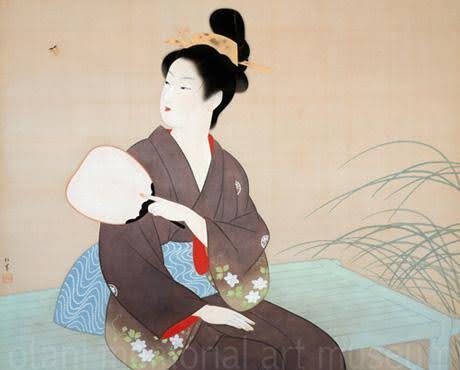6.蛍 1943年
(Hotaru 1943)
昭和期の精神美と夕涼みの情景

《蛍》は、上村松園が1943年に描いた作品。女性が夕暮れに蛍を眺める一瞬を捉えた、静謐で詩的な美人画。花柄の小袖をまとい流水模様の帯を締め、髪型は兵庫髷(ひょうごまげ)で元和〜寛文期の風俗を反映した衣装様式。彼女の傍らには一匹の蛍が舞い、夕涼みの情景が静かに広がり女性の視線や所作によって、しとやかな空気感が巧みに表現されている。背景を極限まで省略し人物と蛍だけで物語を紡ぐ構成は日本画の「余白の美」を体現している。
蛍は日本文化において「儚さ」「季節感」「幽玄」を象徴する存在。松園はその一瞬の光を女性の精神的な美しさと重ね合わせることで、戦時下においても失われない静かな希望を描き出した。この作品は松園が晩年に到達した「真・善・美」の理念を凝縮した一作である。
Hotaru (Firefly)
Spiritual beauty of the Shōwa era and a tranquil scene of a summer evening
Painted in 1943, Hotaru is a serene and poetic depiction of a woman gazing at a firefly at dusk. She wears a floral-patterned kosode and a sash with flowing water motifs, her hair arranged in a Hyōgo-mage—a style reflecting fashions from the Genna to Kanbun periods. A single firefly flutters beside her, and through her gentle gaze and composed posture, the tranquil scene of a summer evening is delicately expressed.
The background is intentionally minimized, allowing the viewer to focus solely on the woman and the firefly—an embodiment of yohaku no bi, the Japanese aesthetic of meaningful emptiness. In Japanese culture, fireflies symbolize transience, seasonality, and a sense of mystery. Uemura overlays this fleeting glow with the spiritual elegance of womanhood, expressing a quiet hope that endures even in times of war.
This work distills the ideals of truth, goodness, and beauty that Uemura pursued in her later years.
お問い合わせ
〒154-0024 東京都世田谷区三軒茶屋1-39-7